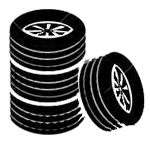Why is it so important to change the timing belt on a [DSM]?
Similar Questions:
What happens if the timing belt breaks on a [DSM]?
Why is it so important to change the balance shaft belt on a [DSM]?
What happens if the balance shaft belt breaks on a [DSM]?
Brief answer: most belt failures on DSM engines result in major internal engine damage, and very high repair bills.
With the exception of the 1.8L NT engine, DSM engines are of the 'interference' style. This means that the pistons and valves occupy the same space, but not at the same time. This type of engine design might seem stupid, but is done for many reasons. (1.8L owners please note that you are not necessarily immune to these problems - keep reading.)
Of course, the engine needs some mechanism for ensuring the pistons and valves don't try to occupy the same space at the same time. The component that does this job is (you guessed it) the timing belt. It's main function is to keep the position of the camshafts (which run the valves) and the crankshaft (which runs the pistons) constant. So long as this is true, it is not possible for the pistons to hit the valves.
There are several reasons why the timing belt mechanism might fail. Obviously, if the timing belt itself breaks because of stress, age or contamination, the valves and pistons will get out of sync. Less obvious is the possibility for damage by the often-unnoticed balance shaft belt.
The balance shaft belt (known as timing belt B in dealership circles) has a much less important job than the main timing belt. It's function is to operate one of the balance shafts in the engine, a component that does nothing but smooth out the engine vibration. Balance shafts are not essential in an engine, and many engines don't have any at all. If the balance shaft belt should break, the worst symptom the driver should notice is an increased 'buzziness' to the engine.
Unfortunately, it's usually not that simple. This little balance shaft belt runs immediately alongside the main timing belt. If it breaks, it almost invariably strikes the timing belt with great force. This results in one of two things: either the main timing belt breaks as a result of the impact, or it 'skips' - that is, jumps teeth on the gears - and the timing between the crankshaft and camshafts becomes radically incorrect. Either way, the end result is usually the same.
Should the timing belt break, the camshafts will be held in a static position while the crankshaft is still turning. In other words, the pistons will be moving, while the valves will be staying still. If the valves are stuck in a position where they are 'in the way', the pistons will strike them during their normal travel.
A similar problem exists if the timing belt has skipped out of position. Although it is still driving the camshafts, it is causing the valves to open at the wrong time. Often, it is the same time during which the pistons are trying to use the same space inside the cylinder, and the pistons will still hit the valves.
During these encounters, the valves almost invariably lose, and get bent out of shape. They are then unable to do the job of sealing the cylinder intake or exhaust ports, and the engine cannot run. This is a virtual certainty on the 2.0L turbo and non-turbo engines, but even 1.8L owners have been known to have similar problems.
Since many of the DSM engines have 4 valves per cylinder, there is a high probability that at least one valve per cylinder will be bent, no matter what position the camshafts are in. Most owners find they lose at least half the valves (all the intake or all the exhaust valves), and many find all sixteen valves are damaged. A compression test usually tells the sad tale: zero pressure in the cylinder because a valve is stuck open.
Unfortunately, the only way to repair these valves is to remove the head from the engine. The 'head' is essentially the top half of the engine, which holds virtually everything in an engine aside from the cylinders, pistons and crankshaft. To get it off, about half of the engine components must be removed and/or disconnected. While it is off, the head must also be reconditioned and inspected for damage. All of this translates into major labor and high repair bills.
Sometimes the pistons are dented or gouged as well, requiring them to be replaced. This usually involves the 'block', or bottom half, of the engine to be removed from the car, which requires even more labor as well as the cost of new pistons.
The moral of this story is: always change your belts, on schedule, with the best replacement parts you can afford. This is truly a situation where an ounce of prevention is worth a pound of cure, as engine repairs cost three to six times as much as timing belt changes.
Those who dislike the idea of keeping the balance shaft belt in the engine may wish to consider removing the shafts - Has anybody ever removed the balance shafts in a [DSM]? .
QA #168
Last Updated:
2016-08-15 09:42







